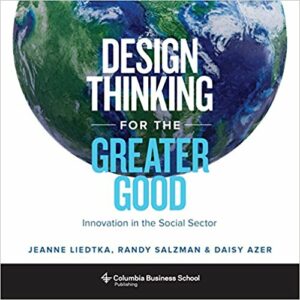Innovation in the Social Sector
Design thinking is one way to reframe problems, ideate solutions, and iterate toward better answers. It helps solve wicked problems. Those are the type that are especially insidious and difficult.
In a new book by Jeanne Liedtka, Daisy Azer, and Randy Salzman, Design Thinking for the Greater Good: Innovation in the Social Sector, the authors take on the challenge of applying design thinking to the social sector. The principles apply to all organizations and may help you reach a breakthrough in your organization. I recently spoke with Randy Salzman about their research. Randy is a journalist and former communications professor. His work has been published in over one hundred magazines, journals, and newspapers, from the Wall Street Journal and the New York Times to Mother Jones, Bicycling, and Style.
Practice Design Thinking
What is design thinking?
Design thinking is a modern version of what was once common, a method of addressing and solving problems outside of normal professional siloes. After about 500 years of ever-greater specialization, society is recognizing that wicked problems lie between the professions, between those siloes, and that most “answers” require a grasp of human behavior and a willingness to deeply understand the entire problem, not just “my” professional aspect of it. Design thinking, often called human-centered design, asks us to explore deeply, empathize continually, ideate rapidly, prototype simply and iterate constantly in order to address the problems that bedevil us. Unlike, for example, LEAN and most analytical methods of addressing problems, design thinking seeks to hold problem-solvers in the question space, rather than rapidly jumping to an answer as most Type A personalities – who corporate leaders tend to be — do. Reframing the question, exploring it deeply—and especially building solid empathy with users and other stakeholders—allows design thinkers to find unarticulated needs and desires and build solutions—tapping into unintentionally hidden aspects of human behavior. In today’s “quantitative” planning world, design thinking seeks to return to “qualitative” understanding of both bigger, and littler, picture issues.
It is being used today all over the world in a variety of very different organizations. Would you give us a few examples?
While many know of the success of Intuit, 3M, Proctor and Gamble and other major corporations in producing new products and services via design thinking approaches, less is known about the problem-solving methodology’s work outside of product development, and in social sector and government organizations. Today, many U.S. government bureaucracies – from Health and Human Services, the VA, even the armed forces – are today seeking to understand the people they serve at a much deeper level than treating people as numbers using a quantitative statistical approach. Non-profits, hospitals, and educational institutions are also adapting their thinking towards design-thinking’s “possibility first, constraints later” approach to problem solving. For instance, The Kingwood Trust in the United Kingdom is using design thinking to sense and adapt to the needs of autistic adults who cannot use written or oral language to even express their likes or dislikes, and involving them in the design of their living spaces. The Community Transportation Association of America is using it to build local capacity to solve the work-transport needs of lower income employees. Monash University Hospital in Australia has completed a dozen design thinking projects and are presently engaged in solving the truly “wicked” problem of how medical providers can deliver and be compensated for wellness instead of for providing interventions. All these stories are in our book, Design Thinking for the Greater Good: Innovation in the Social Sector. But the stories are too many to fit into any book. We only touched on the New Zealand government’s culture-wide tipping to design thinking. Most governmental ministries in that Pacific nation have a design-thinking shop aimed at exploring deeply and empathizing continually with the stakeholders they serve.
How is innovation shifting?
We like to talk in terms of a shift from “Innovation I” to “Innovation II” and liken to this shift to the one that occurred in quality, post WWWII. In the same way that quality was originally the realm of specialists and then gradually (facilitated by TQM) spread to the point where, today, quality is everyone’s job up and down the organization, innovation is increasingly seen as belonging to those outside of research & development and senior executives. For organizations to adapt and thrive in today’s climate of political and economic uncertainty and challenge, we submit that all staffers, all employees, need the training and authority to innovate. It must become a core organizational capability. In this environment of broadened responsibility for finding new ways to create value for stakeholders, design thinking can do for innovation what TQM did for quality – help us to teach, scale and democratize it.
Certainly, possibilities for innovation are accelerating for a variety of technological reasons, from big data to computing capacities. There has been less attention to the human dimension, to the awareness that flawed human beings do not behave like the so-called “rational consumers” the quantitative planning world was based on. As the authors of Nudge put it, man is not “homo economous” but “homo sapiens,” and until thinkers began to understand that most of us act without thinking – rationally or otherwise – very little qualitative understanding of human behavior was considered by “garage” and other technological innovators. Now—in what some are calling the “Smart Machine Age”—there is an awareness that every idea and every concept needs accompaniment from a social technology which aids in its spread. We think of design thinking as a social technology for change. As more and more business, governments, organizations recognize that a qualitative understanding of their stakeholders is needed, design thinking opens up a new kind of conversation that creates space for innovation to birth and blossom.
Embrace the Growth Mindset
You contrast “Geoffrey” and the growth mindset with “George” and the fixed mindset. What lessons can we learn from their approaches? What can leaders do to encourage the best mindset for innovation?
George and Geoffrey are archetypes – manager personas who exemplify the extremes of a button-downed analytical approach (George) and a wide-eyed creative one (Geoffrey). These characters are famous – or perhaps infamous – for opposing each other across most major organizations. Based on the analysis of Stanford University psychologist Carol Dweck, who suggests humans begin developing either a “fixed” or a “growth” mindset almost from birth, we argue that Georges (fixed) tend to stay close to their professional silos for much of their careers while Geoffreys (growth) tend to wander throughout various functions, roles and even organizations. This results in different perspectives that can, and should, complement each other. In our design thinking methodology, we provide tools for these two mindsets not only to communicate without the historic rancor but also to build on each other’s strengths. Primarily, we show George how to quiet his skepticism and preference for analytical tools and work with Geoffrey’s wide repertoire and empathy to develop a portfolio of ideas, and then demonstrate with Geoffrey how to design and conduct experiments to test these ideas. Together, George and Geoffrey make a dynamic team. Opposed they are no team at all.
Our work indicates that blocks to innovation don’t necessarily emanate from the C-suite; they are often the works of peers and immediate managers who stymie innovative Geoffreys. Being harried, as many mid- and lower-level managers are—having ascended to leadership by playing it safe and mastering the existing system—any change, in itself, implies the risk of failure.
Organizations need the Georges – who competently run the existing system – to recognize that their expertise is, instead, greatly needed by the Geoffreys—but only at the appropriate moment—not before the organization’s Geoffreys “explore deeply” and “ideate rapidly.” Assuring George that his analytical skills are needed for assumption testing (and all ideas have multiple assumptions) and for devising learning launch criteria is key. Conversely, good senior management will seek out the Geoffreys in the organization and teach them the value which George brings to the table.
Primarily, however, to begin spreading design thinking and innovation throughout the organization, senior leaders should build an innovation program which is open to any and all employees. Nothing illustrates management’s commitment to collaborative creativity more than an ongoing program – something like the US Health & Human Service’s “Ignite Accelerator” – which invites and rewards employees who seek change.
Many think about brainstorming and ideation immediately, but you spend a great deal of time laying the foundation for innovation. Why is this so important? What do you notice if this is short-circuited?
Our “What is” question, the first of four in the design thinking methodology, is where a considerable amount of an innovation team’s time should be spent. Understanding stakeholders is difficult, but if a team doesn’t dig deeply to discover, and empathize with, potential stakeholders as human beings, not as spreadsheet data points, it will likely miss the most effective innovation opportunities. Yes, many front-line staffers do indeed have a great grasp of customers, but – being human – unaided they still come with their own biases, and they still see issues and challenges from the perspective of the organization. Solid ethnography allows design teams to observe the key stakeholder in his or her natural habitat and draw empathetic insights which build powerful parameters for what eventual solutions will look like. Generally speaking, most humans cannot conceive of products, services, or information that they don’t already have, minimizing the effectiveness of surveys and focus groups. But through design thinking tools like “journey mapping” and “job to be done” analysis, an ethnographer can see the highs and lows of any client’s experience and uncover deeper needs and then figure out how to minimize the lows and maximize the highs.
Often, when teams jump immediately into brainstorming and ideation, they end up solving the wrong problem—or the problem that key stakeholders care little about—because the problem is seen from the organizational perspective. A powerfully diverse team – with Georges and Geoffreys coming from many organizational areas (and even outside the organization) – will bring multiple perceptions. Only through “exploring deeply” and “empathizing continually” can the team discover unarticulated needs.
4 Questions
Would you share the four-question methodology?
 Our 15-step design thinking methodology is designed specifically for teaching George personalities, and encouraging them to develop creative confidence and try collaborative creativity. Our four questions (“What is,” “What if,” “What Wows,” and “What Works”) provide the big picture and outline the process while the 15 steps provide assurance and stability as teams work through a new, and seemingly confusing, process. When teams complete their ethnography, for example, they often have mountains of qualitative data which they are unsure how to utilize because it can’t be easily synthesized. Geoffreys, who usually enjoy this ambiguity, tend to find a quote or story which highlights a possible new approach, but George tends to seek comfort in sample size and statistical significance. Ethnography, with its small sample size and need for more iterative pattern finding makes him uncomfortable. Having the step box to check off assures him that even if he has concerns and is unsure if he’s done X correctly, he and the team are advancing in the process.
Our 15-step design thinking methodology is designed specifically for teaching George personalities, and encouraging them to develop creative confidence and try collaborative creativity. Our four questions (“What is,” “What if,” “What Wows,” and “What Works”) provide the big picture and outline the process while the 15 steps provide assurance and stability as teams work through a new, and seemingly confusing, process. When teams complete their ethnography, for example, they often have mountains of qualitative data which they are unsure how to utilize because it can’t be easily synthesized. Geoffreys, who usually enjoy this ambiguity, tend to find a quote or story which highlights a possible new approach, but George tends to seek comfort in sample size and statistical significance. Ethnography, with its small sample size and need for more iterative pattern finding makes him uncomfortable. Having the step box to check off assures him that even if he has concerns and is unsure if he’s done X correctly, he and the team are advancing in the process.
In the four-question methodology, we treat everything as a hypothesis and seek multiple viewpoints. The “What is” question explores the present situation, again primarily as seen by the stakeholder, not the organization. “What if” is the “ideate rapidly” stage where design thinkers use brainstorming and concept clustering to develop a series of “napkin pitches” – or big ideas which address the issue or challenge. In “What If,” we seek only possibilities, withholding any constraint discussion until the testing stages of “What Wows” and “What Works.” “What Wows” is the beginning of testing one or more of those napkin pitches by, first, challenging as many assumptions behind it as possible, and then developing barebones prototypes to explain it to potential users. These co-creators bring insight from the client perspective, and then design thinkers can either shelve the idea or adapt it for “learning launches” in “What Works.” A learning launch is not a pilot, and the goal isn’t to polish and finish the idea. It’s to learn and adapt, again keeping the option of “calling the baby ugly.”
Throughout this process, the prototype and plan “iterates constantly” as design thinkers work to assure that their “brilliant idea” truly is of interest to customers before asking organizational accountants to loosen check books.
What ways do leaders establish, maintain and increase the momentum of change? How do leaders encourage a culture that supports design thinking?
Change management theorists point to four factors that are essential to encouraging change: dissatisfaction with the status quo, the clarity and resonance of a perceived new future, and the existence of a clear pathway to get there, all balanced against any professed loss associated with the change. The good news for leaders is our research for Design Thinking for the Greater Good: Innovation in the Social Sector (DT4GG) that all four are positively affected by design thinking. Ethnography with its deep immersion into users’ lives builds dissatisfaction with the inadequacies of today. Prototypes help us build clear pictures of tomorrow. The iterative nature of design thinking puts us on a path to move from concepts to reality. And design’s emphasis on co-creation invites into the innovation conversation all of the key players, reducing the sense of a loss of control for those involved.
Another key takeaway from DT4GG and lessons for leadership is the power of the avoidance of top-down standardization in favor of locally-determined, customized solutions and processes. For a large organization, standardization may seem efficient in the short run, but in today’s complex world, adaptability favors solutions grounded in local realities. When local staffers are part of the change, they find it powerful instead of the pain and loss associated with change done TO them.
Another message for leaders is the importance of having a portfolio of potential solutions – not just one “game changer.” This, of course, is the mindset of venture capitalists: make small bets fast and then see which ideas blossom. After having many ideas, design thinkers test the assumptions, co-create with stakeholders and iterate to discover the best answer(s) for any particular moment in our complex times.
Perhaps most importantly, upper management can provide a structured innovation methodology along with the opportunity to learn it well. In years of working with typical organizational managers – usually Georges, usually non-designers — we have found these employees desire a structured creativity process (which may sound like an oxymoron, but isn’t) to integrate innovation into day-to-day practice. Encouraging employees at all levels to explore deeply, empathize continually, ideate rapidly, prototype quickly and iterate constantly is the winning formula in today’s world. Sometimes all the best leaders can do is to set up employees for success – and then get out of the way.
The Uniqueness of the Social Sector
Many of these ideas apply to every organization, but you focus on the social sector and the greater good. What’s unique about the social sector that caused you to focus like this?
As lead author, Dr. Jeanne Liedtka, is a business strategist at University of Virginia’s Darden Business School, we have already dealt with design thinking in the corporate world. (See Designing for Growth, The Catalyst, and Solving Problems with Design Thinking.) During research for those books, stories from the social sector were discovered and international analysis of so-called “wicked problems” — where any solution changes the definition of the problem — grew substantially. With non-profits and governments having more critical bottom lines, it became obvious that design thinking is critically applicable to these intractable, wicked problems—more applicable than “just making a buck.”
In seeking social sector stories for D4GG, we discovered that there are thousands, perhaps millions, of innovators striving – often succeeding and often being frustrated – in non-profit and governmental worlds, and we wrote this book for them. Our nine stories of success (and one of failure) will, we hope, provide those frustrated innovators with ammunition for helping their peers and bosses see why their operation should consider adding design thinking to the organizational tool kit. (The Designing for Growth Field Book provides the “how.”) And we applaud the successes – from increasing blood donations in Peru to helping poor teenagers get drivers licenses (and therefore jobs) in New Zealand, to keeping California drop-outs in school, to actually communicating with the autistic who can’t use normal language, to connecting subsistence farmers with agricultural researchers in Mexico – which are changing society for the better. The people behind these, and a thousand other innovation projects, are the people improving life on our planet.
For more information, see Design Thinking for the Greater Good: Innovation in the Social Sector.


